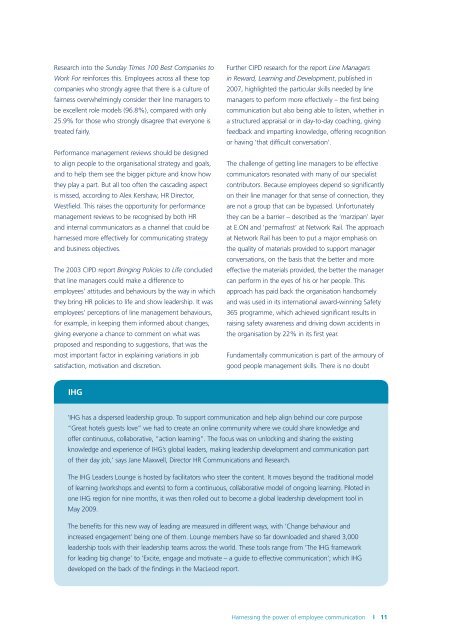Harnessing the power of employee communication - CIPD
Harnessing the power of employee communication - CIPD
Harnessing the power of employee communication - CIPD
Create successful ePaper yourself
Turn your PDF publications into a flip-book with our unique Google optimized e-Paper software.
Research into <strong>the</strong> Sunday Times 100 Best Companies to<br />
Work For reinforces this. Employees across all <strong>the</strong>se top<br />
companies who strongly agree that <strong>the</strong>re is a culture <strong>of</strong><br />
fairness overwhelmingly consider <strong>the</strong>ir line managers to<br />
be excellent role models (96.8%), compared with only<br />
25.9% for those who strongly disagree that everyone is<br />
treated fairly.<br />
Performance management reviews should be designed<br />
to align people to <strong>the</strong> organisational strategy and goals,<br />
and to help <strong>the</strong>m see <strong>the</strong> bigger picture and know how<br />
<strong>the</strong>y play a part. But all too <strong>of</strong>ten <strong>the</strong> cascading aspect<br />
is missed, according to Alex Kershaw, HR Director,<br />
Westfield. This raises <strong>the</strong> opportunity for performance<br />
management reviews to be recognised by both HR<br />
and internal communicators as a channel that could be<br />
harnessed more effectively for communicating strategy<br />
and business objectives.<br />
The 2003 <strong>CIPD</strong> report Bringing Policies to Life concluded<br />
that line managers could make a difference to<br />
<strong>employee</strong>s’ attitudes and behaviours by <strong>the</strong> way in which<br />
<strong>the</strong>y bring HR policies to life and show leadership. It was<br />
<strong>employee</strong>s’ perceptions <strong>of</strong> line management behaviours,<br />
for example, in keeping <strong>the</strong>m informed about changes,<br />
giving everyone a chance to comment on what was<br />
proposed and responding to suggestions, that was <strong>the</strong><br />
most important factor in explaining variations in job<br />
satisfaction, motivation and discretion.<br />
Fur<strong>the</strong>r <strong>CIPD</strong> research for <strong>the</strong> report Line Managers<br />
in Reward, Learning and Development, published in<br />
2007, highlighted <strong>the</strong> particular skills needed by line<br />
managers to perform more effectively – <strong>the</strong> first being<br />
<strong>communication</strong> but also being able to listen, whe<strong>the</strong>r in<br />
a structured appraisal or in day-to-day coaching, giving<br />
feedback and imparting knowledge, <strong>of</strong>fering recognition<br />
or having ‘that difficult conversation’.<br />
The challenge <strong>of</strong> getting line managers to be effective<br />
communicators resonated with many <strong>of</strong> our specialist<br />
contributors. Because <strong>employee</strong>s depend so significantly<br />
on <strong>the</strong>ir line manager for that sense <strong>of</strong> connection, <strong>the</strong>y<br />
are not a group that can be bypassed. Unfortunately<br />
<strong>the</strong>y can be a barrier – described as <strong>the</strong> ‘marzipan’ layer<br />
at E.ON and ‘permafrost’ at Network Rail. The approach<br />
at Network Rail has been to put a major emphasis on<br />
<strong>the</strong> quality <strong>of</strong> materials provided to support manager<br />
conversations, on <strong>the</strong> basis that <strong>the</strong> better and more<br />
effective <strong>the</strong> materials provided, <strong>the</strong> better <strong>the</strong> manager<br />
can perform in <strong>the</strong> eyes <strong>of</strong> his or her people. This<br />
approach has paid back <strong>the</strong> organisation handsomely<br />
and was used in its international award-winning Safety<br />
365 programme, which achieved significant results in<br />
raising safety awareness and driving down accidents in<br />
<strong>the</strong> organisation by 22% in its first year.<br />
Fundamentally <strong>communication</strong> is part <strong>of</strong> <strong>the</strong> armoury <strong>of</strong><br />
good people management skills. There is no doubt<br />
IHG<br />
‘IHG has a dispersed leadership group. To support <strong>communication</strong> and help align behind our core purpose<br />
“Great hotels guests love” we had to create an online community where we could share knowledge and<br />
<strong>of</strong>fer continuous, collaborative, “action learning”. The focus was on unlocking and sharing <strong>the</strong> existing<br />
knowledge and experience <strong>of</strong> IHG’s global leaders, making leadership development and <strong>communication</strong> part<br />
<strong>of</strong> <strong>the</strong>ir day job,’ says Jane Maxwell, Director HR Communications and Research.<br />
The IHG Leaders Lounge is hosted by facilitators who steer <strong>the</strong> content. It moves beyond <strong>the</strong> traditional model<br />
<strong>of</strong> learning (workshops and events) to form a continuous, collaborative model <strong>of</strong> ongoing learning. Piloted in<br />
one IHG region for nine months, it was <strong>the</strong>n rolled out to become a global leadership development tool in<br />
May 2009.<br />
The benefits for this new way <strong>of</strong> leading are measured in different ways, with ‘Change behaviour and<br />
increased engagement’ being one <strong>of</strong> <strong>the</strong>m. Lounge members have so far downloaded and shared 3,000<br />
leadership tools with <strong>the</strong>ir leadership teams across <strong>the</strong> world. These tools range from ‘The IHG framework<br />
for leading big change’ to ‘Excite, engage and motivate – a guide to effective <strong>communication</strong>’; which IHG<br />
developed on <strong>the</strong> back <strong>of</strong> <strong>the</strong> findings in <strong>the</strong> MacLeod report.<br />
<strong>Harnessing</strong> <strong>the</strong> <strong>power</strong> <strong>of</strong> <strong>employee</strong> <strong>communication</strong> 11

















